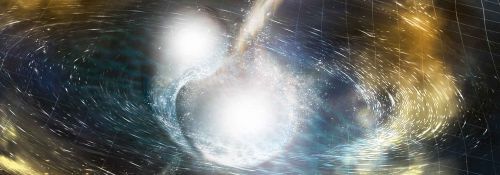
Hillsdale College Physicist Part of Groundbreaking Astrophysics Discovery
Hillsdale physics professor Ryan Lang involved in project that detected both gravitational waves and light from the collision of neutron stars
Hillsdale, Mich. – The Laser Interferometer Gravitational-Wave Observatory (LIGO) Scientific Collaboration and the Virgo Collaboration announced today that gravitational wave detectors in the U.S. and Italy, as well as dozens of ground and space observatories, have made the first detection of both gravitational waves and light emanating from the collision of two neutron stars, a detection termed “multi-messenger” astronomy. Ryan Lang, assistant professor of physics at Hillsdale College, worked on this historic achievement.
Gravitational Wave Research at Hillsdale College
“Neutron stars are some of the most exotic objects in the universe,” said Lang. “By carefully studying the gravitational waves from merging neutron stars like these, we can learn about the fundamental structure of matter.”
Lang has been working in the field of gravitational-wave science for twelve years and with the LIGO project since August 2015, research that this year earned three of the project’s physicists a Nobel Prize. He is one of only three professors from Michigan institutions who are participating in the international collaboration.
“This is an incredible day for the astrophysics world,” said Dr. Lang. “The detection of both gravitational waves and light from the merger of these neutron stars has fulfilled the promise of LIGO and Virgo as astronomical observatories. We have learned many new things that we could not have determined with either piece on its own. The era of multi-messenger astronomy has finally begun.”
At Hillsdale College, Lang works students to develop and use the computer codes which search LIGO and Virgo data for gravitational waves, with a particular focus on intermediate-mass black hole binaries. Lang also participates in the LIGO Education and Public Outreach group, which develops and disseminates resources to help the general public understand LIGO’s discoveries. He attended today’s press conference as well.
Detection of GW170817
The observation, labeled GW170817, took place on August 17, and was made by the two Advanced LIGO detectors in Louisiana and Washington. The Advanced Virgo detector in Italy also found a small signal which, when combined with the information from the LIGO detectors, allowed the source of the waves to be localized more precisely than any gravitational waves detected previously. Analysis of the waves revealed that two massive objects had collided about 130 million light years from Earth. The masses of the objects were determined to be about 1.1 to 1.6 times the mass of the sun, much smaller than the masses of the four merging black hole pairs previously observed by Advanced LIGO and Advanced Virgo. These masses are consistent with neutron stars, the smallest and densest stars known to exist. Neutron stars are only about 20 kilometers, or 12 miles, in diameter, but contain so much mass in that small volume that a teaspoon of neutron star would weigh about a billion tons on Earth.
Within seconds of the gravitational-wave detections, a coinciding burst of gamma rays was observed by NASA’s Fermi Gamma-ray Space Telescope. Theorists have long suspected that gamma-ray bursts like this one are caused by the mergers of neutron stars. The simultaneous detection of GW170817 and a short gamma-ray burst confirms this theory.
Theorists have also predicted that the initial “fireball” of gamma rays should be followed by a mini supernova-like event called a kilonova. With coordinates provided by the three-instrument gravitational wave detection, optical telescopes were able to search the sky and find this new point of light. About 70 space and ground observatories ultimately observed the source emitting different forms of light, or electromagnetic radiation: X-ray, ultraviolet, optical, infrared, and radio. These observations have shown that heavy elements, like gold and platinum, are created in neutron star collisions and then spread throughout the universe, again answering a long-standing question in astrophysics.
Press Conference and Publications
Representatives of the LIGO and Virgo collaborations discussed GW170817 at a press conference in Washington, D.C. today. The scientists explained the process and significance of the detection from both the gravitational-wave and electromagnetic perspectives. Physical Review Letters has published a paper detailing the LIGO-Virgo detection, and additional papers from the collaborations and their astronomical partners have been submitted to or accepted by various journals.
About LIGO and Virgo Scientific Collaborations
LIGO is funded by theNSF, and operated by Caltech and MIT, which conceived of LIGO and led the Initial and Advanced LIGO projects. Financial support for the Advanced LIGO project was led by the NSF with Germany (Max Planck Society), the U.K. (Science and Technology Facilities Council) and Australia (Australian Research Council) making significant commitments and contributions to the project. More than 1,200 scientists and some 100 institutions from around the world participate in the effort through the LIGO Scientific Collaboration, which includes the GEO Collaboration and the Australian collaboration OzGrav. Additional partners are listed at http://ligo.org/partners.php. The Virgo collaboration consists of more than 280 physicists and engineers belonging to 20 different European research groups: six from Centre National de la Recherche Scientifique (CNRS) in France; eight from the Istituto Nazionale di Fisica Nucleare (INFN) in Italy; two in the Netherlands with Nikhef; the MTA Wigner RCP in Hungary; the POLGRAW group in Poland; Spain with the University of Valencia; and the European Gravitational Observatory, EGO, the laboratory hosting the Virgo detector near Pisa in Italy, funded by CNRS, INFN, and Nikhef.